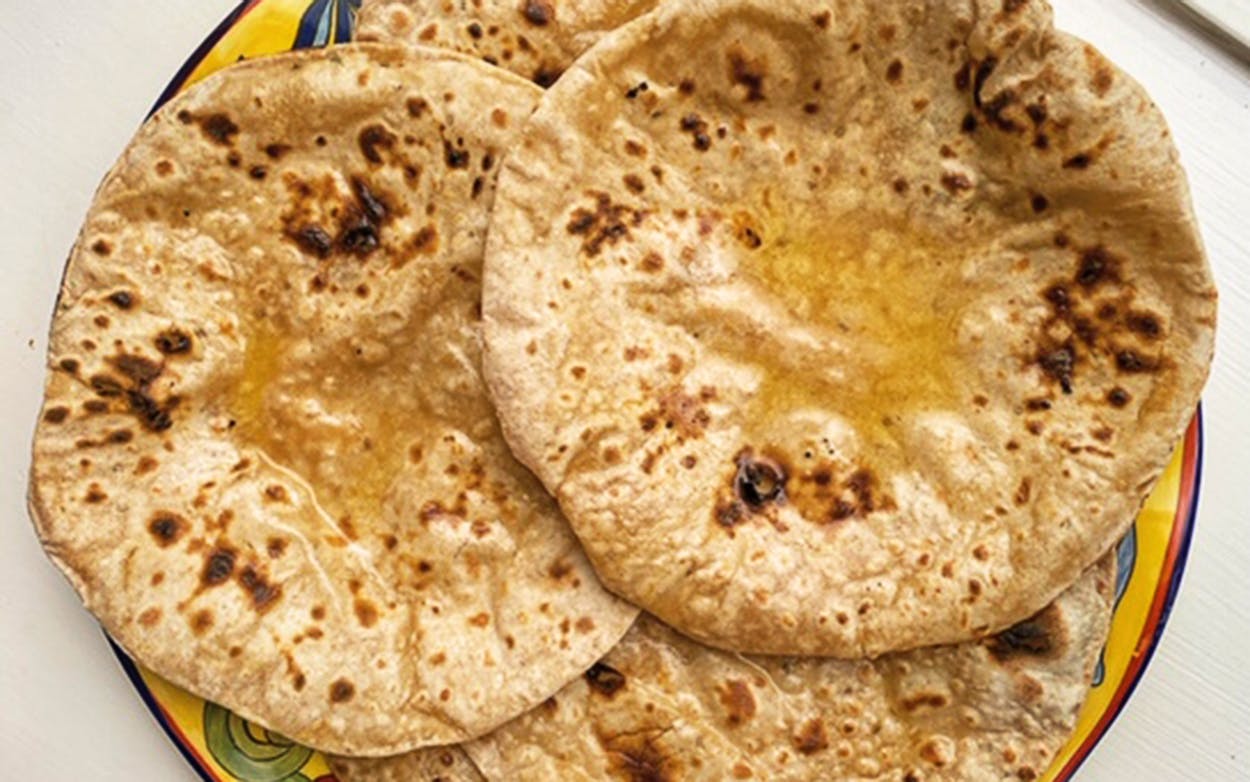I’ve been thinking a lot about those simple moments from dining out that we don’t get to enjoy right now in Dallas. The first sip of a crisp lager on a sunny day at Katy Trail Ice House. The crunch of an onion ring straight from the fryer at Burger House. The delightful refreshment of the sugarcane juice at Agha Juice. I am in an incredibly privileged position to have a home, enough food, and my parents around me. But as someone whose job it is to track down one-of-a-kind restaurants and chefs, I can’t help but daydream about dining out.
But here’s the thing: those simple, joyous food moments can also be experienced at home, in different ways. Just-whipped whipped cream. A perfectly ripe avocado. Here’s the one I keep going back to, week after week: fresh roti.
In some households, freshly made roti is a regular occurrence. In mine, it wasn’t for the majority of my upbringing. My mom had a busy job in the software industry, and most nights, she would get home around 6 and turn dinner around by 6:30. Purchased roti became her go-to shortcut (it’s worth mentioning that she did teach my dad, who worked from our garage, to cook, but fresh roti wasn’t deemed a priority lesson). We found a caterer in Irving and took weekly trips to her house to pick up packets of fresh roti. Eventually, my mom discovered that the whole-wheat tortillas at Central Market were a pretty great roti substitute—we loved the soft, chewy texture and how you could see the flecks of wheat in each one. A few years ago, when Patel Brothers opened in Irving, we became immediately obsessed with the machine in the Indian market that constantly spews out pillowy rounds of roti. We would buy them by the dozen to store in our freezer. But I have always known, in the back of my mind, that nothing beats the real thing.
A few weeks ago, my mom announced ceremoniously that she was going to make fresh roti. I honestly couldn’t remember the last time she had made it for me. She finally had the time, she said (in addition to being quarantined, she’s retired). Also, she reminded me, roti is very intuitive to make. You start out with a cup of wheat flour (multigrain flour works too), and you add enough water to make it come together in a ball. A pinch of salt and, if you want, a little red chile powder, and then let it rest for about twenty minutes. Separate the roti into smaller balls, roll them out into thin circles, and cook them on both sides in a pan. Then, you take each cooked roti and flip it repeatedly over an open flame to give it those signature dark-brown blisters.
Now for the best part: as soon as the roti is off the flame, you rub ghee all over the surface, giving it this beautiful, barely golden sheen. I’ve eaten at least a dozen of these over the past two weeks, and I can tell you that a fresh roti rubbed generously with clarified butter tastes of pure happiness. It’s good enough to make me forget, if even for just a minute, that I haven’t left the confines of my house all week.
I see my friends finding simple joys in other acts of cooking—and by that, I mostly mean sourdough bread. But I want to make the case for roti. It doesn’t require cultivating a starter. It doesn’t take much time. And the end result, in my opinion, is just as satisfying.
My mom has now made fresh roti at least once a week. We’ve been eating roti with everything, not just our sabzi and dal. We’ll roll up leftover potatoes in them to eat like burritos. We’ll cover the roti with mozzarella and tomatoes and make roti pizza. But there is no better way to eat roti than seconds after it’s made, stained with ghee. It’s nothing fancy, and that’s precisely what makes it so perfect.
- More About:
- Priya Krishna






